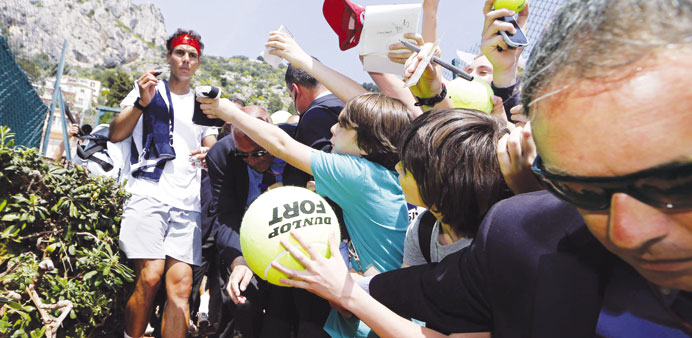Security hold back fans who wait for an autograph by Spain’s Rafael Nadal (L) following a training session in Monaco yesterday.
DPA/Monte Carlo
What can a sportsman do when he loses the adrenaline of competitive play due to injury?
Former world number Rafael Nadal remained out of the ATP Tour for seven months, and golf and poker helped to keep him sane.
“Those were the only two things in which I could really compete over those months, golf and poker. I’m a competitive person, I like sports, and through all that time I could not practice movement sports,” Nadal told dpa at the current Monte Carlo Masters.
As he prepared to launch today his bid for an unprecedented ninth consecutive title in Monaco, Nadal admitted that he is still “scared” that his knee might not withstand the stress so soon after a double injury.
At age 26, with close to a decade on the ATP Tour, Nadal’s passion for winning remains intact and is in fact reloaded after his long injury break. For this reason, it is somewhat surprising that he insists he is not the top favourite to win a tournament in which he has won 44 of his 45 matches.
“I know it’s hard to understand, but you cannot win all the time.
In life and in sport nothing lasts forever,” Nadal said.
He is far from contemplating an early retirement: he keeps the Rio de Janeiro 2016 Olympics as he biggest goal after missing London 2012. And he wants to keep competing, fighting and winning matches in which rivals have him against the ropes.
“I’m a very active person,” he says.
Nadal was not allowed to run or jump for several months as he recovered from a partially torn ligament in his left knee.
Golf and poker became his refuge, to the relief of his family who know Nadal is hard to handle when he is “caged in.”
“I hate lying on the sofa watching TV,” he says.
In fact, Nadal has good memories of his latest injury break at home in Manacor, on the Spanish Mediterranean island of Majorca.
“I was happy, (though) not as happy I could get to be some day when I quit playing tennis,” he said. “Though I was surrounded by the people I love and who love me, my head was always on playing tennis again and on competing again.”
Without tennis, he sought other ways to avoid a sedentary lifestyle.
“I learnt to play poker. I did not understand the game, and now I understand it I see it’s fun, competitive. You need to have self-control, to measure times in which you can attack or defend,” he says.
Golf also requires self-control. Nadal takes it very seriously, to the point where some of his occasional rivals laugh behind his back at his concentration and his will to win.
Still, Nadal does not see himself attempting to become a professional golfer, a task at which former world number one Ivan Lendl, Andy Murray’s current coach, once tried his luck, and failed.
“I don’t feel that good,” Nadal says. “If someone comes up to me at 18 and says he wants to be a tennis pro, I’ll advise him to try but tell him he probably will not make it. At 27, 31, 32 or 33, when my (tennis) career ends, I will not have the opportunity to become a golf pro. I will improve my handicap, but to be a professional you need to start as a child.”
Nadal, the winner of seven editions of the French Open, has won three tournaments and lost a final in the four events he has played since he returned to the tour, far beyond his greatest expectations. However, he remains vigilant.
“My only fear, and of course I am still scared, is about when I may get to feel that the knee is completely strong again, 100 per cent,” he told dpa.
However, such fears have nothing to do with his tennis, he stresses.
“I have to think positive, I cannot think that I’ve forgotten how to play tennis in seven months,” Nadal said.

